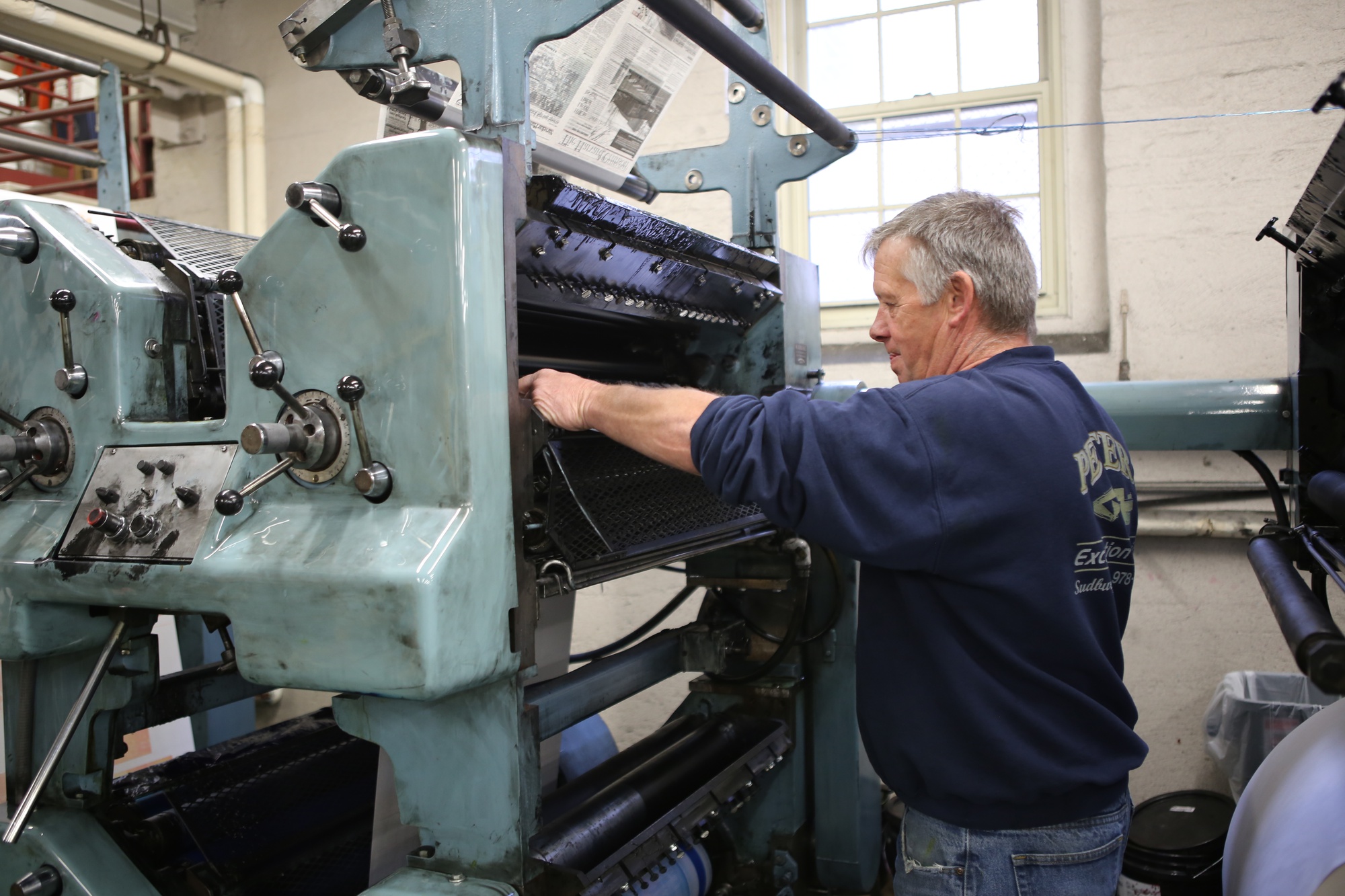
Meet the Printers
It’s 6:12 a.m. when Brian Byrne fires up the printing press housed in the basement of 14 Plympton St. It’s a late start for him today.
On a typical morning, Byrne arrives before 6 a.m. to print The Crimson’s daily newspaper. From the moment he turns the press on, it runs for less than 20 minutes—glossing ink onto the impossibly thin pages, then folding them carefully into the final product. His hands are quickly stained black. “The ink never actually dries,” he says, “it just soaks into the pages.”
George Diguardi, Byrne’s printing partner, initially throws copy after copy into a recycling bin. Prepping the twine he will use to tie the bundles of newspaper, Byrne waits for the perfect print.
Before long, Byrne picks one up to check the color photos on the front page. “I used to be able to tell without this thing!” he yells, pulling out a tiny magnifying glass to check for unequal color balances. With expert precision, he adjusts various levers and pulleys along the press.
“I used to develop the pages in trays with negatives and everything,” Byrne says. Over the years, the printing process has become faster, and The Crimson has cut the number of papers it prints. Less work also means Byrne shows up to the Crimson later in the morning than he did in 1981, when he first started the job at age 26.
Over the years, Diguardi has made no such adjustment. Since starting his job as computer-to-plate operator in 1989, Diguardi has arrived at work every morning at 3:45 a.m. His first task is transferring the digital copy of the newspaper to giant plates, which he then places on the press.
Byrne, the only person at The Crimson who knows how to operate the press machine, handles the machinery work. Diguardi bundles and ties the papers before delivering them across campus—a job that students used to do, but Diguardi himself took over last fall.
“They’re unreliable,” he says, “So I do it now.”
While Byrne runs up and down the press, explaining the mechanics, Diguardi stands by the end, bundling papers into compact packages. He only speaks one time. “You’ve got blue!” he yells, before dumping the freshest batch of papers into the recycling.
Before we head out for delivery, I grab one of the rejects from the bin. From a quick glance, it looks fine to me.
“Don’t let George smoke with you in the car,” Byrne says as we walk upstairs.
Byrne keeps tabs on everyone at The Crimson. “I call her the queen,” he says of the accountant, Elizabeth Woodley. “She does whatever she wants.” His laugh rings out into the darkness.
It’s now 6:40 a.m., and the rest of Byrne’s day is lined up. He’ll probably go inside to do some maintenance on the building. He’ll leave around 1 p.m., go home to his wife, and maybe work on their house for a little.
The early hours at The Crimson have allowed Byrne to spend a lot of time with his family over the years. His cabinets are covered with taped -together articles and photos of his children playing sports. When they were growing up, he says, he never missed one of their games.
As Diguardi and I bounce along the streets of Harvard Square in his old Ford, the heater is blasting and the car beeps at us the whole time. Diguardi, unbothered, makes no moves to put his seatbelt on.
The best part of the job? “In the morning when I get to make the plates, and no one’s around,” he says.
“That’s my favorite.”
I get out of the car at Kirkland and walk with Diguardi to the dining hall before we silently part ways. I sit down with a cup of coffee and open the newest issue of The Crimson. A small blue line marks the top of the pages.
Running my finger across it, the ink leaves a bit of residue on my skin—a mark of subtle imperfections, discarded and corrected before most of us have even opened our eyes.


